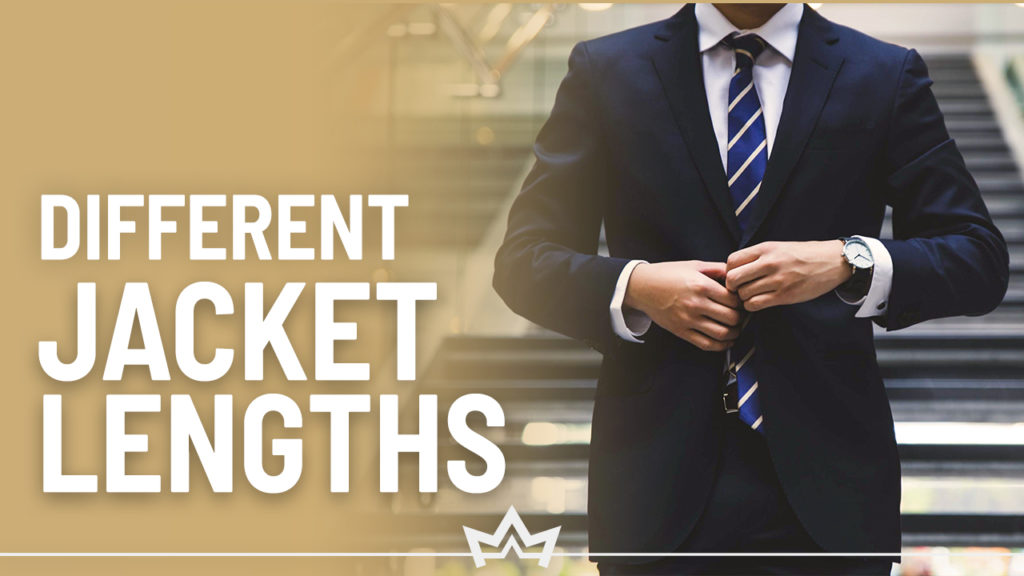Welcome to the world of responsible suit-wearing, where you measure yourself for a suit!
Taking your measurements for a perfectly fitting suit is the single best thing you can do to secure a professional and sophisticated suit.
Whether you want to ensure you pick out the best-sized suit that fits correctly or order a custom suit, knowing your measurements gets you as close as possible to a perfect suit.
Before Measuring for a Suit
When you’re getting ready for a new suit before you even begin measuring, it helps if you get familiar with how suit sizing works.
Suit jackets are sized by length and chest width. They don’t work quite the same way that your casual clothes do.
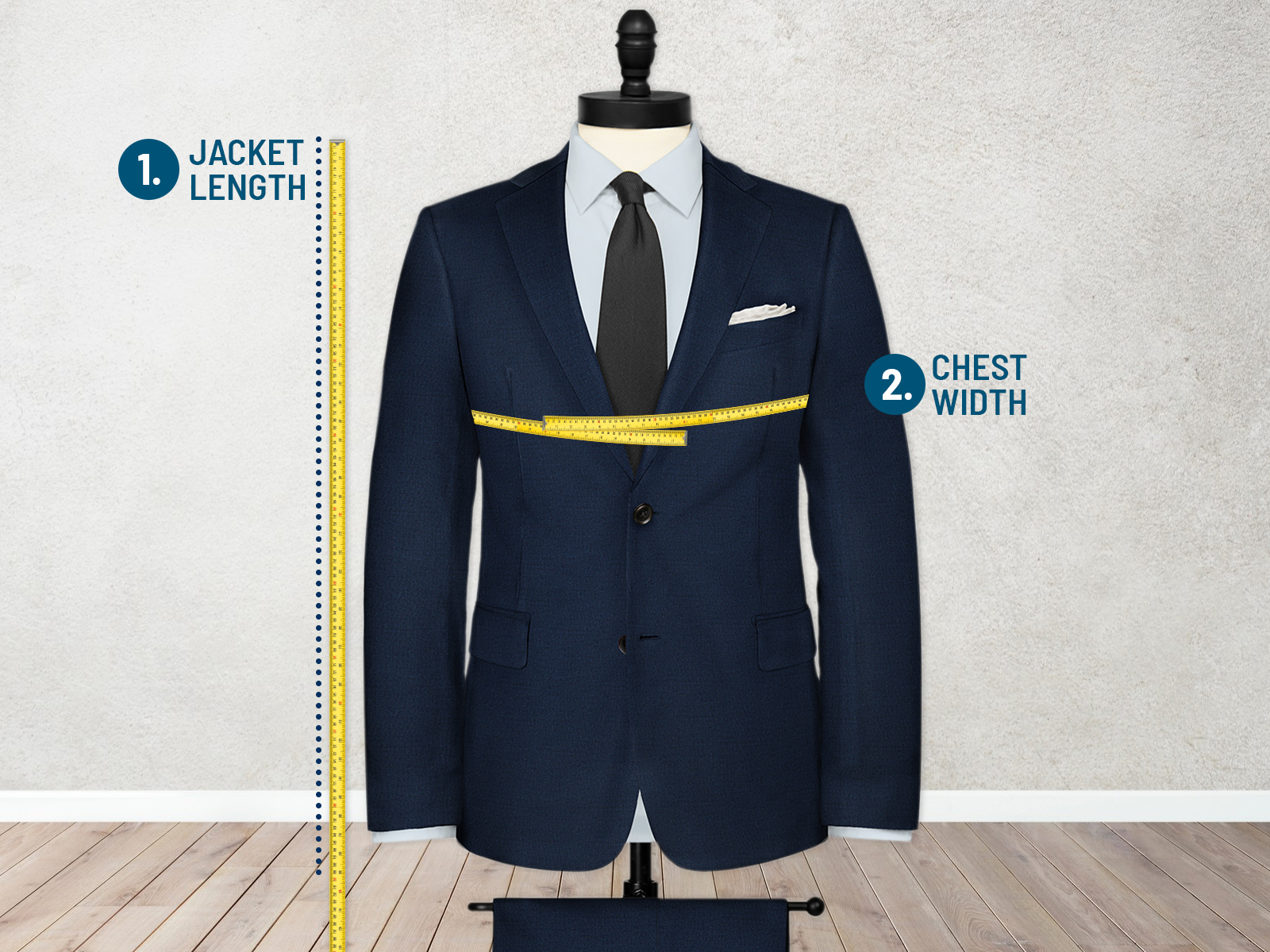
So, you’ll see a number and letter(s) designating those particular areas.
The numbers are the size in inches of the jacket’s chest. These roughly reflect your actual chest measurement.
The letter refers to the jacket’s length: short (S), regular (R), or long (L), and it reflects your overall height.

Suit pants don’t typically do waist and length, as many other more casual pants do. That’s because most suit pants come with an unfinished hem.
So instead, suit pants will be measured only by waist size.
Suits usually fit a bit tighter than the same measurements on casual clothing because they don’t have as much give as less dressy clothes.
Measure Your Height
If you don’t know your exact height, now’s the time to figure it out.
It can be easy to do yourself. Stand straight against a wall and lightly mark the top of your head with a pencil.
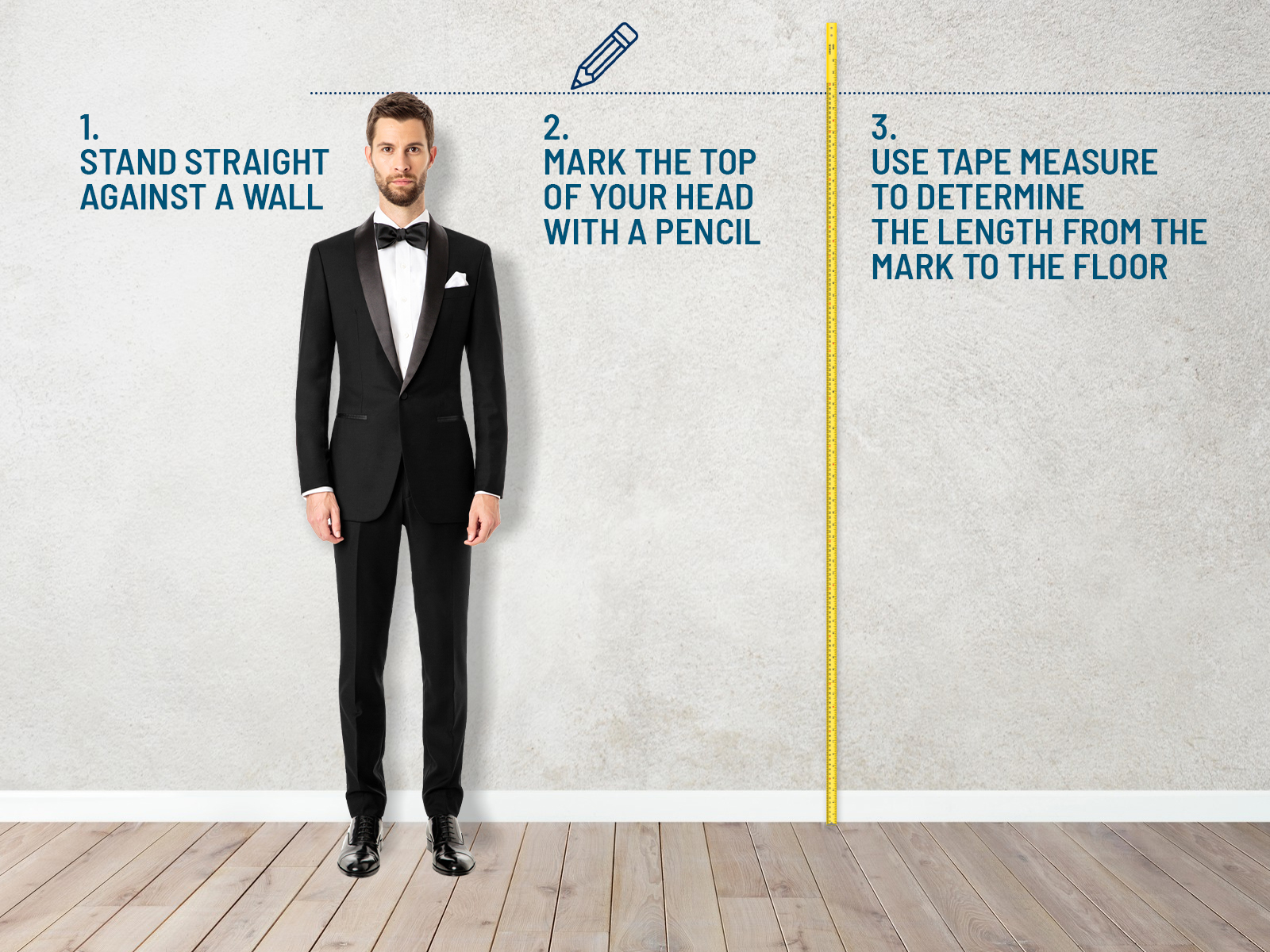
Next, measure the length from that mark to the floor with a tape measure.
Knowing your height for certain suit measurements, such as jacket length and the drop for your pants, is helpful.
How Should the Suit Jacket Fit
A proper fit is vital to look good when wearing a suit.
But how can you determine if your suit fits you correctly? The main key lies in a few areas to check.

First, look at your suit jacket when it’s buttoned.

If it hangs loosely around your middle, it’s too large. If you notice cinching and pulling around your waist and the bottom spreads open, it’s too small.
Next, take a close look at your jacket’s shoulders. If the jacket seams extend beyond the tips of your shoulders, it’s too big.

But your suit jacket is too small if you see ripples along your shoulders from the material being pulled; your shoulders should resemble a flat surface.
Finally, you must ensure the proper length for your suit jacket.

A jacket is too long if its hem reaches as far as your fingertips. But it’s too small if it doesn’t go past your wrist.
Your suit jacket hem should end around the meat of your palm when your hands are relaxed at your side.
Proper Suit Pants Fit
The most critical aspect of a good-fitting pair of suit pants is the waist.

It should rest comfortably at your waist, just above your hips.
Ideally, you shouldn’t need a belt to help hold your pants in place; if you do, they’re too large.
The pant leg hem should hit the top of your shoe.
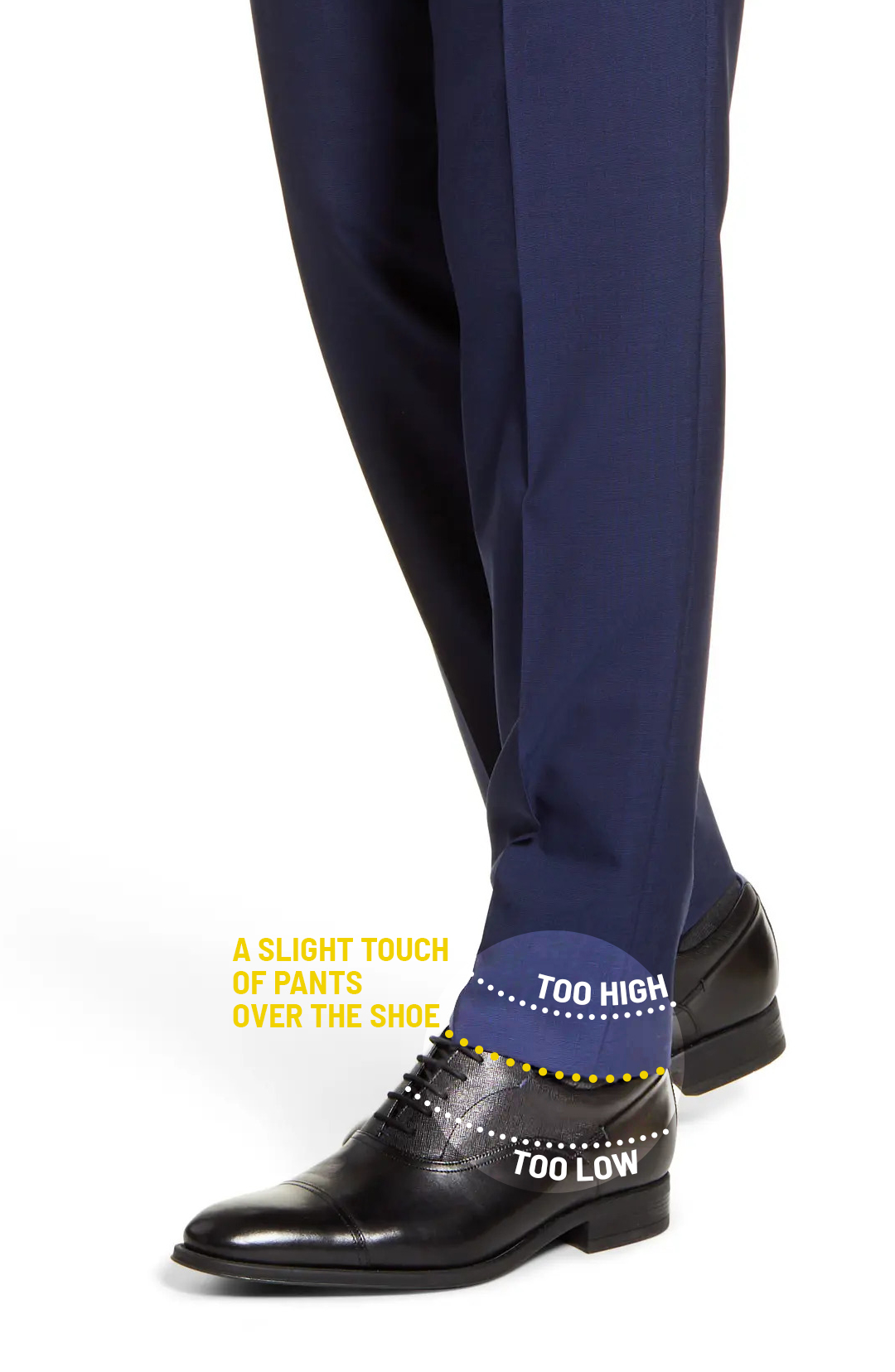
A break in your pants or a small fold of fabric sitting on top of your foot is acceptable, but don’t let the pants be so long that they drag behind your heel.
On the other hand, don’t allow your hem to be short enough to show some ankle because that’s too short.
How to Measure for the Suit Jacket
Before you begin measuring for your new suit, you’ll need a few items on hand.
Get a good, reliable cloth measuring tape. Don’t use anything else; it’s imperative that you get perfectly accurate measurements.
Keep a paper and pencil nearby so you can jot down the numbers as you go.
Most importantly, have somebody to help you hold the tape measure. Some of these measurements definitely require extra hands.
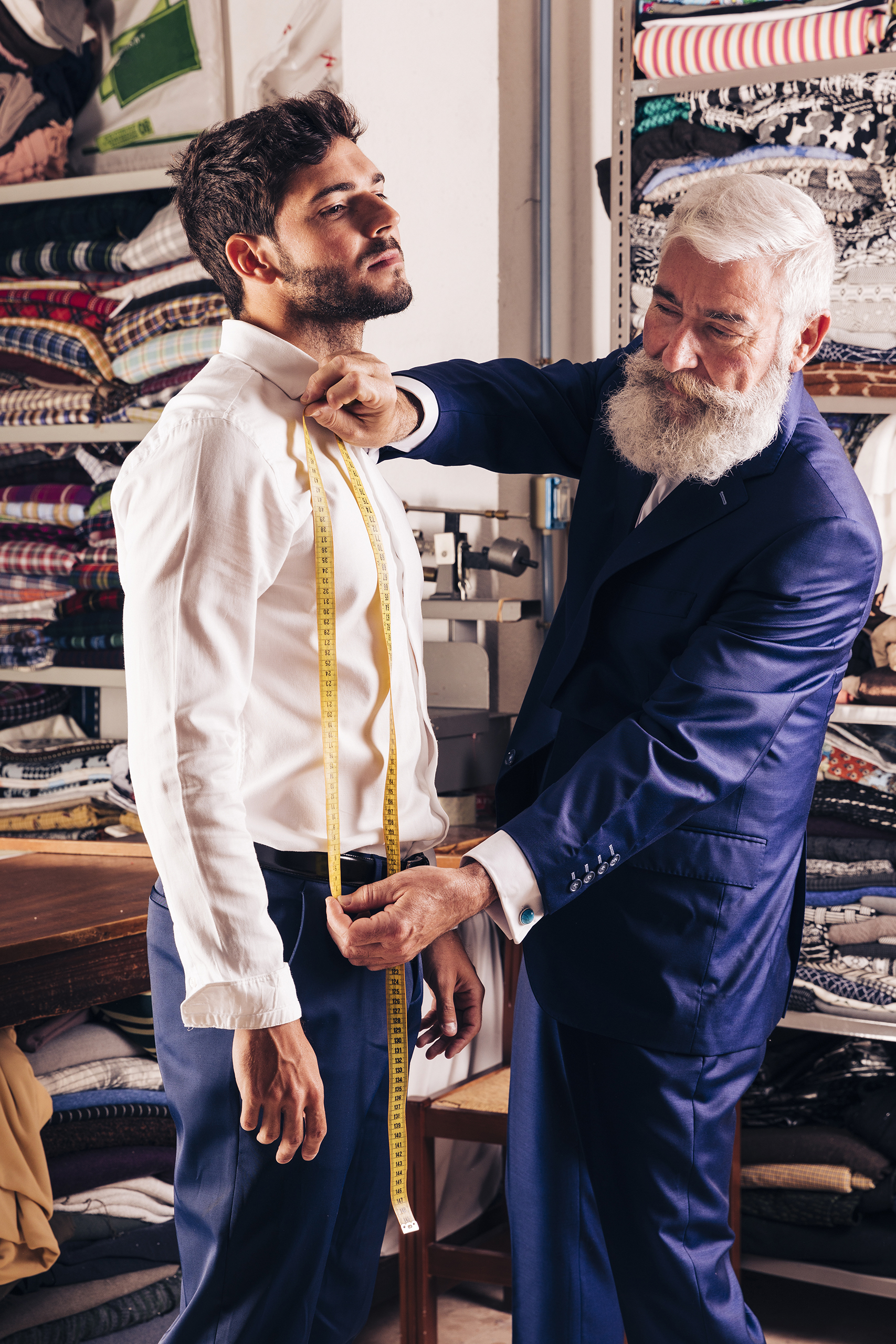
Put on a dress shirt before you start measuring. It will provide a more accurate reading for your suit jacket.
If you usually wear an undershirt, put that on now, too.
Always measure twice to double-check your accuracy.
Measure Around Adam’s Apple for the Neck Size
This may seem like an inconsequential measurement now, but you’ll be thankful for it once you button your dress shirt collar.

You want that button to rest on your adam’s apple, obviously not too tightly but also not so loose you get a noticeable gap.
Stand straight and tall, but relaxed, not tense.
Place the end of the tape measure at your adam’s apple and gently pull the tape all the way around your throat.
Check for comfort; stick a finger between the tape and your neck.
Identify the Shoulder-to-Shoulder Width
This measurement is tricky to get accurately, so you’ll absolutely want your measuring buddy to help you here.
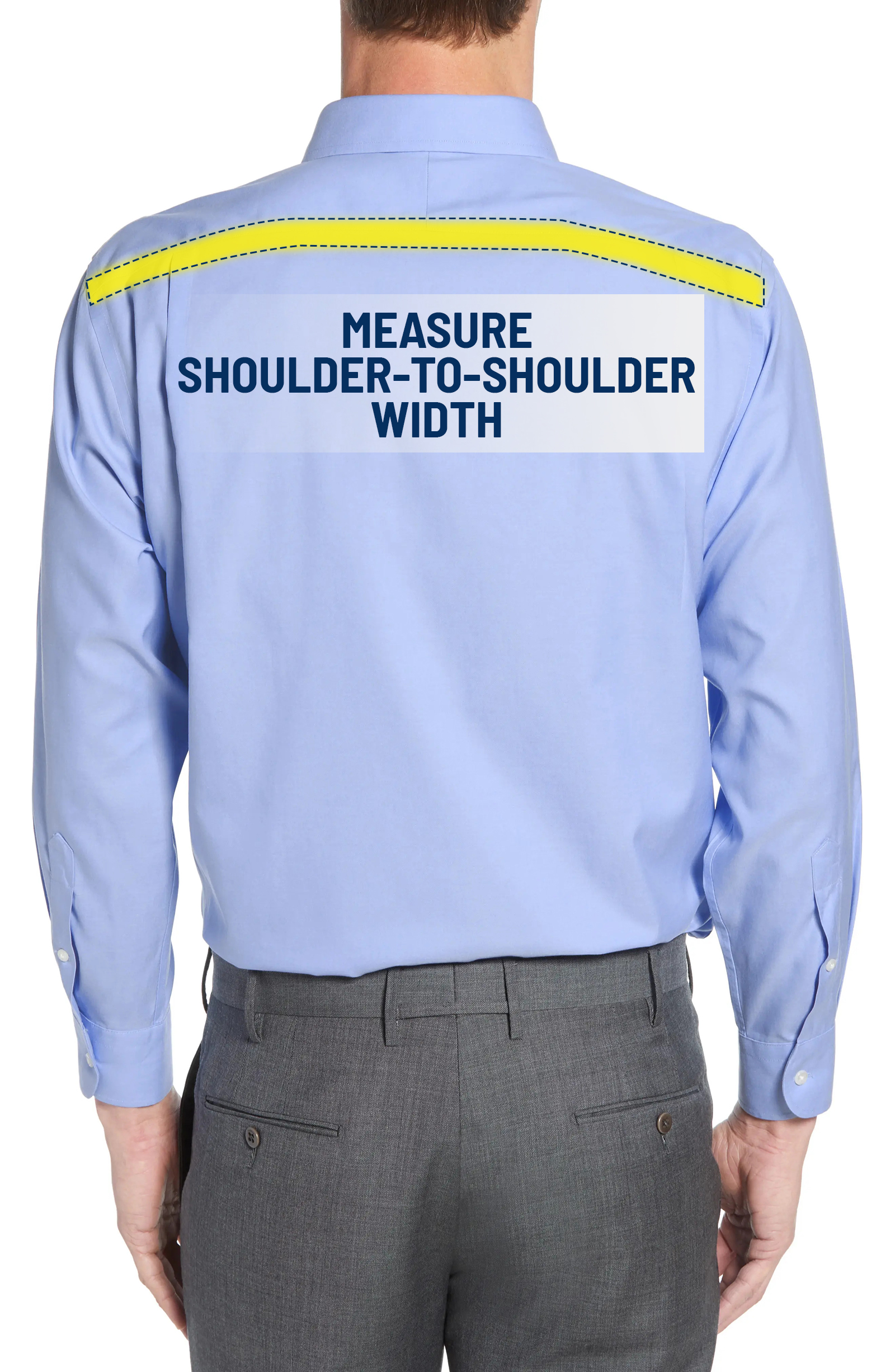
Locate the tops of your shoulders. You can use a well-fitted dress shirt as a model since its shoulder seams are helpful guide posts.
Put the tape measure at the seam of one shoulder tip.
Standing tall, extend the tape across the curve of your back to the same point on the other shoulder.
Again, it’s best if someone can help you take the shoulder width measurement. It will look like this:

Remember to follow the curve of your upper back.
Measure the Widest Part of Your Chest
You want to get this measurement accurate because it can’t be easily fixed if it ends up wrong on the suit.

Not only will this measurement impact your suit fit, but also how comfortable it feels.
Adopt a neutral stance, where you’re relaxed with your arms loose at your sides. Do not tense up or inflate your chest.
Find the widest spot across your chest, usually at the nipple line.
Wind your measuring tape fully around this spot and insert a finger or two for slack.
Remember to keep the tape under your arms for this measurement and to keep it level all the way around.
Get the Overarm Chest Measurement
This measurement is similar to how you got your chest measurement, only now the tape goes over your arms, as well.
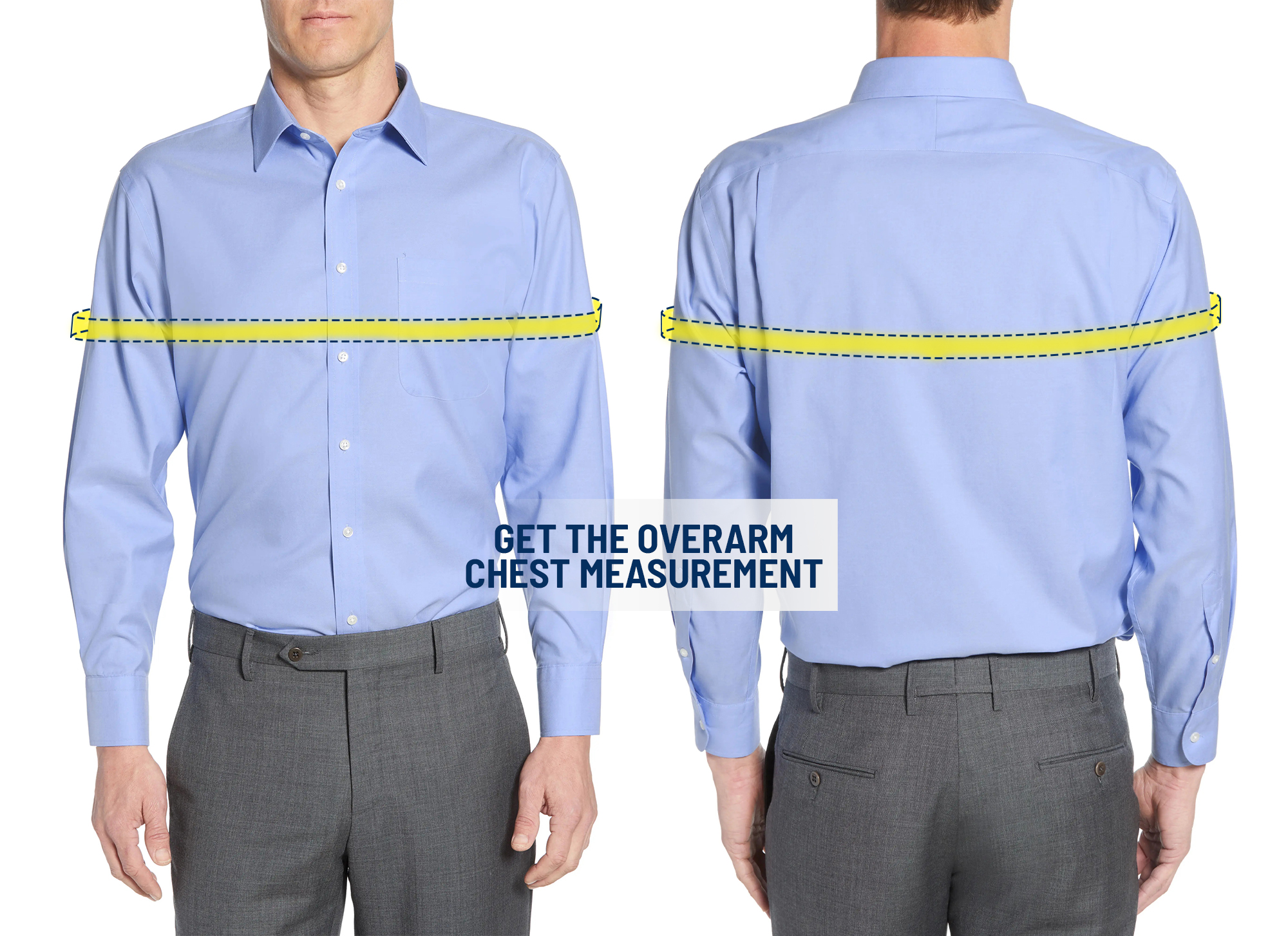
Again, you’re looking for the broadest part of your chest, so use the same spot. This will also get your biceps.
It’s an essential measurement in determining your suit jacket size.
Determine the Body Waist Width
Take this measurement below your chest to determine your suit enclosure.

Again, finding a spot with the most girth is important for an accurate and comfortable fit.
So, you’ll usually discover this means it will be right around your belly button, but adjust your tape measure if that’s not the case.
Remember to insert a finger to factor in ease!
Get the Suit Jacket Length
The measurement for this section will generally be related to your arm’s length.

Once again, stand relaxed with your arms resting at your sides. Look directly ahead.
Start by placing the tip of the measuring tape at the base of your neck.
An excellent guide is the seam of your shirt where the collar meets your shirt’s yoke.
Run the tape smoothly down the center of your back, noting the measurement parallel to where the base of your thumb rests.
Be careful not to angle the tape toward your hand, though. Instead, you need to eyeball it around your upper thigh.
Measure the Sleeve Length from Shoulder to Wrist
The end of your tape measure should start at the tip of your shoulder or where your dress shirt’s shoulder seam lies.
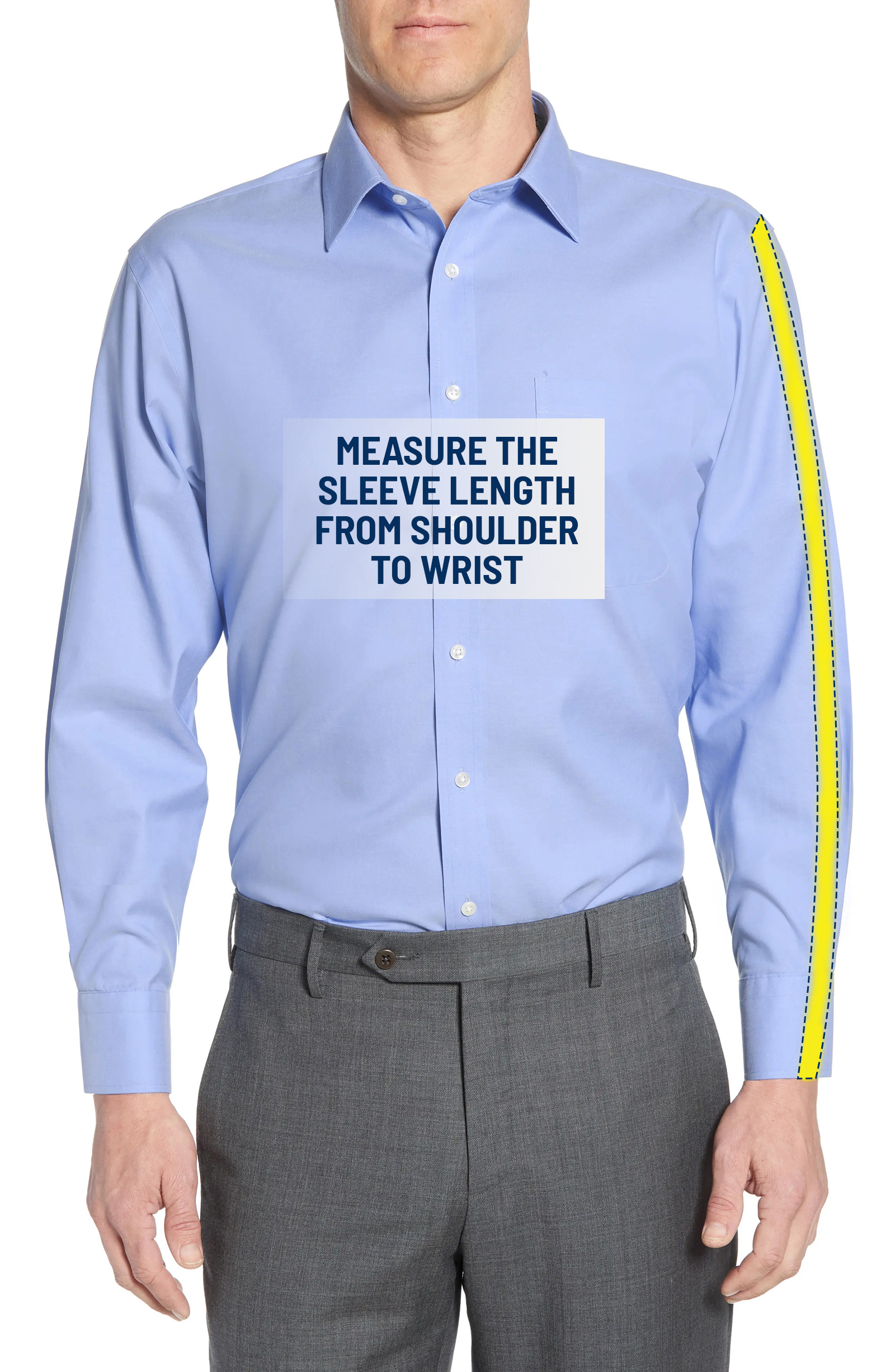
It’s best to keep your arms resting naturally at your sides; be sure to relax them as much as possible.
Measure straight along the outer length of your arm down to your wrist bone.
Some made-to-measure suits request a “coat in-sleeve” measurement; this would be down the inside of your arm.
For this, start the tape measure at your armpit, again going down to your wrist.
Measure Around the Biceps for Sleeve Width
This part is so important to measure if you have any bulk.

Off-the-rack suits don’t usually have allowances for extra room, leading to a tight feeling in your suit jacket.
This time, it’s ok to flex your muscles while measuring.
Bend your elbow so your forearm is parallel to the floor.
Measure the widest spot on your bicep, but remember to insert a finger to give your sleeve some ease.
Wrap the Tape Around the Wrist
Again, here you’ll want the widest part of your wrist, probably at the top of your wrist bone close to your hand.

You should measure around where your suit jacket sleeve hem would fall.
Don’t forget to insert a single finger between the tape measure and your arm.
How to Measure for the Suit Pants
For this part of your measuring, it is best to wear dress shoes similar to the ones you would wear with your new suit, ensuring you get the appropriate height.
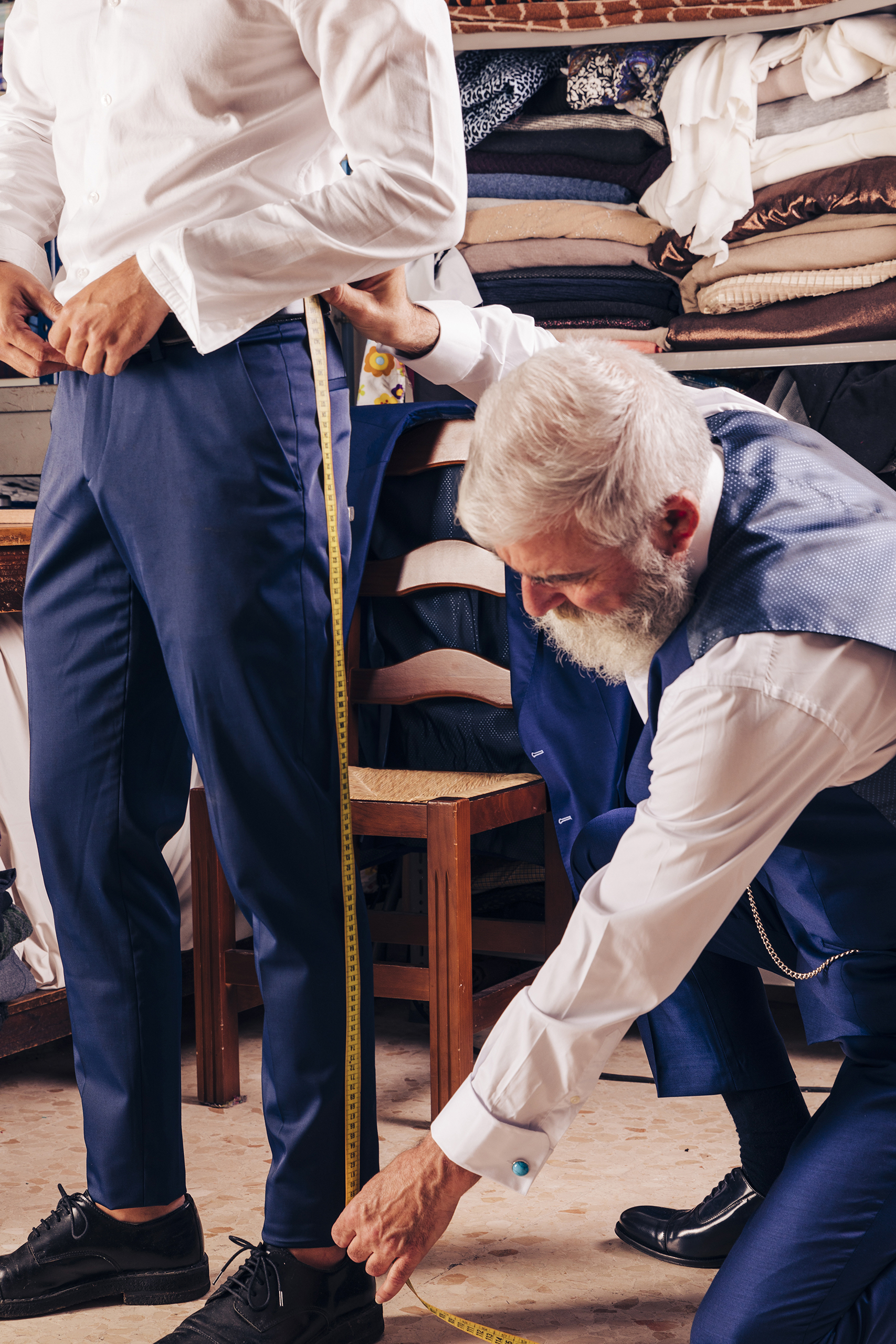
Your dress shoes influence your stance and posture, which both play a great role in how your suit falls; they will also affect the drape of your pants.
Keep your measuring partner close at hand for these next measurements!
Measure Around Your Pant Waist
The best spot to take this measurement is where you usually belt your bants.

Slide the tape measure completely around your waist, inserting a finger before recording your final measurement.
If you’re wearing pants while taking this measurement, pull them down so you don’t run the tape on top of your existing pants.
That part may be obvious, but hey, just in case.
Wrap the Measure Tape Around the Pant Seat
Measure around the buttocks for this part of your suit.

Find the widest area and pull the tape taut, but not tight.
Don’t insert your finger for this measurement; any extra room will make your suit pants baggy, something you need to avoid if you want to look professional.
You want the tape measure to remain parallel around, with no dips or slips.
Get the Outseam by Measuring from Waist to the Bottom
This part is easy if you plan on hemming your suit pants after you get them.
Start the measuring tape at your waist, in the same location you took your waist measurement.
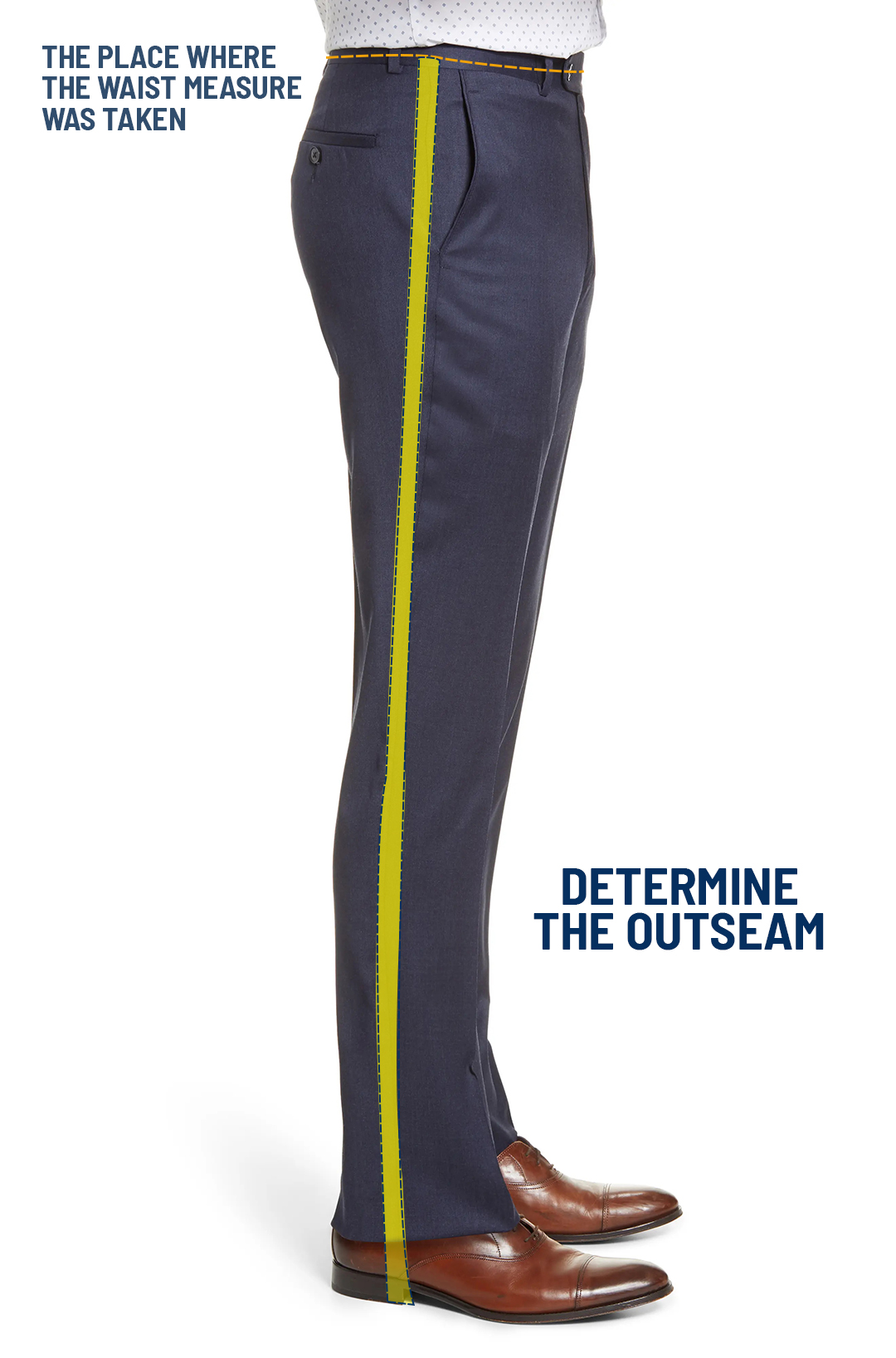
This is very important to start here because it can mess up your sizing if it isn’t in the same spot!
Drop the tape measure along the outside of your leg, all the way until it hits the floor, then subtract two inches to make allowance for your shoes.
If you aren’t leaving your pants unfinished, decide what size break you would like.
Then, stop the tape measure at the area you would guess the pants would fall.
Determine the Inseam by Measuring from Crotch to the Bottom
Put the tape up your inner thigh as high as possible, right at your groin.
Run your measuring tape the length of your inner leg to the bottom of your ankle.

No worries if you’re uncomfortable with somebody else messing around your inner thigh.
You can hold the tape at the top while they deal with your ankle.
Measure the Rise from the Waist to Crotch Bottom
When we talk about “rise,” we’re determining how high up your pants should go on your torso.

You want an accurate rise, so your pants look proportionate to your torso and suit jacket’s length.
Here’s another awkward measuring moment.
Start with the end of the measuring tape at the lowest spot of your crotch.
Then, take it up the back between your legs and mark the measurement at the belt line.
Suit Jacket Sizes vs. Chest Measurement
The number on your jacket sizing is based on your chest measurement, but keep in mind that the numbers won’t match up.
You’ll notice that your suit jacket size will usually be a smaller number than your chest measurement.

That’s because there’s a simple formula; typically, you subtract two inches from your chest measurement to determine your suit jacket size.
Don’t order a suit jacket that’s the same number as your chest measurement; your jacket will look loose and sloppy.
You risk looking like you borrowed somebody else’s suit, which won’t impress anybody.
Different Suit Jacket Lengths
Now, let’s address those letters on your sizing label.
These letters indicate how long your jacket’s body and sleeves are.
Using your measurements, you can decide if you need short (S), regular (R), or large (L). Some companies also offer extra small (XS) and extra-large (XL).

This is where taking your height at the beginning comes in.
- If you are 5’8″ or shorter, you should have a short (S) suit jacket.
- Order yourself a regular (R) suit jacket if you are between 5’8″ and 6’2″.
- Men who are 6’2″ and taller need a large (L) suit jacket.
Differences in Suit Cuts: Classic-Fit vs. Slim Fit
You’ll need to decide how you want your suit to fit you and which look is most flattering on you.
The two most popular suit fits are classic and slim.

A classic fit is a rather loose-fitting suit. It has little shaping or tapering to it, enabling you to move very freely.
Slim-fit suits offer some more structure and shaping but are still a bit roomy.
You’ll still have plenty of movement, but the contouring looks flattering on most body types.
Modern cut suits offer a mix of features from both the slim and the regular fit. They have a roomier chest but are tapered at the waist.
There’s a fourth option; the skinny fit. This type of suit provides very little space and sits very close to your body.
Skinny fit suits look highly tailored but don’t plan on making big movements when you wear one of these.





